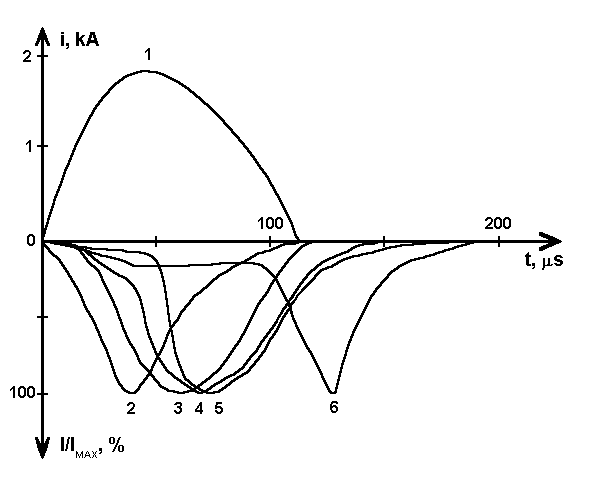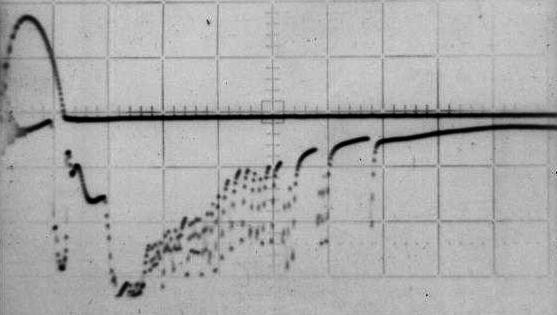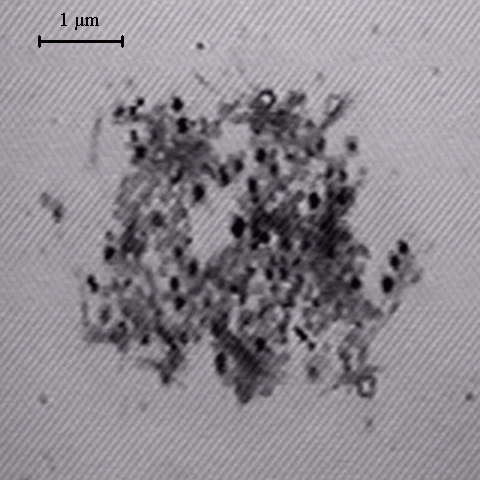|
|
|
Erosive radially-slotted discharge in sheet current mode.
Emelin S.E.a, Pirozerski A.L.b, Mikhailov E.F.b, Vlasenko S.S.b, Skvortsov G.E.c
aScientific-Research Institute of Radiophysics,
bScientific-Research Institute of Physics,
cScientific-Research Institute of Mathematics and Mechanics
at St. Petersburg State University.
ABSTRACT. New non-stationary non-contracted form of the erosive radially-slotted discharge as a thin round sheet with the current of the azimuth direction have been discovered, its existence beings stipulated by a radial transport-wave fluxes. Characteristic features of this discharge is self-confinement of the discharge current magnitude, corresponding decrease of the current pulse duration and occurrence of an energy and substance ejection with rather unusual properties.Measurements of kinetics of the discharge current, the plasma radiation intensity and an electrical probe signal, as well as the transmission electron microscope investigations of characteristic aerodisperse aggregates arising the erosive phase, have been carried out. The probe signal duration was about 10 times greater than that of the current ; its kinetics was complicated suggesting existence in the slot of two components with fundamentally different properties and states of the substance.
Experimental investigations of the erosive capillary discharge [1] have shown that the relaxation time of the radiation of plasma on the basis of a condensed disperse phase can be several orders of magnitude greater than the relaxation time of plasma conductivity. It is in accordance with the approach to erosive plasma as metastable excited substance [1], the concentration of charges and their state have nonequilibrium character [2]. In this case its parameters, in particular, conductivity and sonic speed take a nontrivial kinetics and dependence on temperature, the strengths of exterior electric field and radiation intensity, stipulated by structural transitions [3,4], that manifests itself by appearance of space-time singularities of the characteristics of plasma fluxes and electrical current [2,5-9].
In erosive radially-slotted discharge [5] the mentioned above effects determine existence of the non-stationary form of discharge as propagation of a plasma column along the curvature radius, completed by breaking of the current in the electric circuit.
In the present work the investigations of singularities of radially-slotted discharge is continued for the case of the small value of the resistor and inductance limiting the current. We have found the conditions of the current self-confinement, with the shape of discharge as
a thin sheet and generation of an energy ejection.We used the slotted discharger made up of polymethylmethacrylate [5], with slot diameter 52 mm and initial slot height 0.3 mm. The number of stop gaskets was increased from 10 [5,6] to 21 by installation of supplementary gaskets of width 1.5 mm located in the middle between studs, in addition to the gaskets of width 4 mm located at studs. The interelectrode gasket of fluoroplastic with initial thickness 0.6 mm had the round head of 10 mm in diameter. The electrodes were manufactured of aluminium wire by diameter of 2 mm. The electrode grooves were eliminated from this discharger construction since we had found out that their presence resulted in the instability of a plasma stream on jets formation inside the slot and in a decreasing of the maximal voltage of current self-breaking [6,7].
It was found that when decreasing of the value of the current limiting elements of the discharge circuit the radial velocity of mass transfer within a narrow slot at the maxima of the current exceeded the sonic velocity in the atmosphere.
The plasma volume changed the shape and colour: instead of blue moving column a brighter motionless band appeared. It was located near the head in the case of purely resistive load or near stops in the case of purely inductive load.To obtain the sheet current mode the circuit elements limiting the current were eliminated. The circuit, connected the storage capacitor C=0.8mF, contained, except for the discharger, only an additional resistance Ri=
0.05W for current magnitude measuring and an inductance L=5mH for isolation of break-down ignition circuit; the inductance was separated from the break-down ignition capacitor Cb=1nF x 60kV by an air gap.At voltage of the storage capacitor up to 2.5kV, the break-down resulted in passing through the discharger of a bell-shaped current pulse with duration Tc
~120ms (1.8kV; 1.7kA), the value of equivalent resistance at the current maximum being of ~1W. At the greater initial voltage of the storage capacitor the breaking of the current occurred only after a considerable discharge of the capacitor.Plasma volume (fig. 1) consisted of a very bright central part — "core" which had the form of an incomplete circle with rather sharp exterior boundary, and less bright outer part — "envelope" with lengthy jets located out of a slot.

Fig.1. Integral discharge image.
The "core" exterior boundary expanded with voltage increasing and achieved the stops at the limit value of the voltage. Luminescence characteristics depended strongly on the choice of electrode material.
The first 5-6 mm of a jet near the slot outlet formed an area with considerably reduced radiation intensity which was separated from remaining part of the jet by a sharp boundary.
Running of the plasma onto the stops resulted in the forming of the area of standing waves of radiation intensity with the period somewhat less of the slot height; on the conjugated part of the slot surface arose a system of grooves repeating the radiation intensity distribution.
Oscillograms of the discharge radiation intensity in the axial direction (fig.2, curves 2-6), measured at the points with radial distance from 6 mm to 55 mm by signal of the light-emitting diode AL307AM, had some characteristic differences from the oscillogram of the discharge current (fig.2, curve 1) (initial voltage was 1.8kV).

Fig. 2. Discharge current (1) and relative intensity of
the radiation in axial direction at the points with
the radial distance from 6 mm to 55 mm (2-6).
Everywhere inside the slot the beginning of radiation coincided with one of the current, however maximums of the radiation intensity had a delay with respect to maximum of the current, this delay increasing with radial distance. The trailing edge of the radiation could have a delay up to
10-20 ms with respect to the one of the current. On the outside of the slot at radius 35 mm and more the radiation front had a delay of 45 ms and more (see curves 5, 6). The radiation intensity in the slot diminished in two times on every 5 mm (in average) of radius while in the jets it varied feebly.The leading edge of the signal of an electrical probe, located perpendicularly to the slot near to its outlet in the middle between electrodes, had duration ~4-8
ms and delay from the break-down moment ~30ms. The mean propagation speed of the signal leading edge diminished from 660m/s to 450m/s in the radial distance range of 25-50 mm.At the radial distance of 50 mm, the signal of the electrical probe (fig. 3, the lower curve) had duration of ~ 900
ms, which is about ten times greater than that of the current (fig. 3, the upper curve). Two different stage are distinguished in the signal kinetics. At the first one, the signal increased strongly, its maximum had a delay of 2-3 times over the current pulse duration. At the second stage represent an slow decay with a multitude of large splashes superimposed on it. Each splashes had a very sharp leading edge (< 1ms) followed by an exponential decay with characteristic time ~ 6ms.
Fig. 3. Relaxation of the signal of the electrical probe, located
at the radial distance of 50 mm. Resistance of the probe is 1MW.
The horizontal scale is 100ms/div, the vertical scales for upper
and lower curves are, respectively, 1kA/div and 200V/div;
the period of marks is 2ms.
At the slot height of 0.6 mm and the current limiting resistor of
1.5W, applying of exterior accelerating magnetic field H=2200 Oe, considerably exceeding own field of the discharge current, resulted in a small (~10-15 %) increasing of the maximal current-breaking voltage and in the same diminution of the current pulse duration.At high initial voltages the action of the jets on targets made from thin aluminium foil put over a rigid dielectric plate and from radio-frequency ferrite resulted in damages of the foil and the surface of ferrite, respectively. The passing of the jets into the atmosphere resulted in a loud sound. In the case of sufficiently low voltage, at which the exterior boundary of "the envelope" did not reach stops, the sound created by the discharge was much more feeble or absent.
In this discharge mode the specific energy input was less than ~30kJ/g, or ~2eV/atom, which is few times less than in the capillary discharge [2] (even at the small currents), and also less than the atomization energy of polymethylmethacrylate.
Fig. 4 shows a transmission electron microscope microphotograph of characteristic aerodisperse aggregates arising from an erosive phase generated by the discharge. One can see that the aggregates have a sufficiently compact sphere-like structure by diameter of
2-4mm and consist of a great number of little primary particles by size of about 100 nm. There are primary particles of two types: the carbonic particles (feebly contrast at the photo) which form the base of the aggregate, and the metal ones (hard contrast). Amount of the metal particles is considerably less than that of the carbonic, and they represent isolated inclusions in the aggregate.
Fig. 4. Transmission electron microscope microphotograph
of ejected substance structural residues.
As it was shown in [1], the transient of a discharge interacting with a wall of an easily evaporable dielectric, is accompanied by development of a non-contracted form of discharge characterized by the metastability of energy states of the plasma and increasing of the plasma column cross-section size and of the plasma specific resistance.
The existence of this form of discharge is stipulated by interchange [1] representing a complex of transport phenomena in metastable substance and having a preferential direction. In our case due to the small height of the slot the radial propagation of
a relatively feebly conductive state is conjugate with increasing of the current considerably more slow than it is supposed by parameters of discharge circuit elements. Note that existence of a correlation between the plasma column diameter and relative velocity of current increasing was found also in studies of cathode plasma jets of pulse vacuum discharge [8].The experimental results obtained in the present investigations and earlier point to the normal of the current lines as one of possible directions of the interchange, the interchange rate in this direction increasing with increase of the current lines curvature. This is important for the cases of ring, loop and flowing by heads currents as well as for plasma vortexes in dense mediums and is caused by existence of natural gradients of thermodynamic quantities under these geometry conditions.
Under discharge conditions considered in the present paper the interchange process have following characteristic features:
— arising of the radial flow of energy and substance that leads to the sheet current formation and is accompanied by a relative drop of azimuth conductivity resulting in self-confinement of the discharge current magnitude;
— increase of the plasma column mean radius that diminishes the mean electric field strength;
— increase of the surface area of direct contact of the discharge with the wall that intensifies their interaction.
The electrical probe signal kinetics suggest existence in the slot of two components with fundamentally different properties and states of the substance. The first one, corresponding to the leading edge of the electrical probe signal, is easy ionizable, propagates both in the slot and in the atmosphere with supersonic velocity and, together with the radiation, is responsible for conductivity propagation on a radius. Second component, determining the relaxation the electrical probe signal, propagates much more slowly; its propagation is similar to the throttling in a flat capillary. It has lower conductivity and is accumulated in the slot during short pulse of the discharge; during relaxation it generates splashes of current carriers concentration. Both components propagate faster in the area of basic energy pumping ( in the "core") , than outside of it — in the "envelope".
The accelerating magnetic field test confirms that the effect is determined by radial propagation of the conductive component. The little influence of the magnetic field shows that whilst the forces, causing this propagation, are directly connected with the current magnitude, nevertheless they are mainly of nonmagnetic nature. This seems to be natural for the condensed disperse phase plasma.
In [9] it is pointed out that there exists a connection of relaxing plasma fluxes singularities with a difference of sonic velocities at initial and at final stages of the relaxation. In dusty plasma and condensed disperse phase plasma, due to low magnitudes of sonic velocities and large charges of ionized particles, such difference can be much more significant than in nonequilibrium gas plasma [9]. This agrees with characteristics of the discharge propagation in the form of a solitary wave, observed under the described earlier conditions [5,6]. Therefore one might expect that increase of the non-equilibrium and stability of metastable states should be accompanied by more finer separation of them into phases which differ in temperature, ionization ratio, size of the aggregates, concentration of large multiply charged ions and others; this leads to extension of structural and regime variety of discharges and plasma fluxes types. In the sheet current mode, investigated in the present article, both of the components are initially in the same bulk, but the difference of sonic velocities leads to their relative movement and subsequent separation of the one of the component [1].
It should be noted that under strongly nonequilibrium conditions the excitation of non-linear plasma and sonic waves is possible, that, together with high values of vibrational temperature in "the core" of capillary discharge [10] points to a possible role these waves, included in the interchange spectrum, in the self-organization of plasma fluxes.
The described effects points to the existence of a special form of excited medium activity which manifests itself in capability of the medium, under an influence of gradient character, to pass into a dynamic state [3,4] and to generate an ejection or stream of metastable substance propagating with reduced resistance through the active medium and in the ambient space.
It is conceivable that processes of this type are essential or responsible for appearance of structural singularities of plasma jets and electrode spots in electric discharges. Moreover, it is not unlikely that similar processes, occurred in terrestrial and solar entrails and atmospheres during periods of their high activity, are responsible for luminescence before earthquakes, ball lightning, "sprites", etc. This phenomena can also be considered as the special type of transport in an active medium distinguished by a selective character and stipulated by metastable excited state of the substance. Besides this, the interaction of energy flux with a surrounding medium can be used as a method of pumping and leads to secondary effects [11].